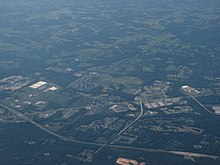

An exurb (or alternately: exurban area) is an area outside the typically denser inner suburban area, at the edge of a metropolitan area, which has some economic and commuting connection to the metro area, low housing-density,[1] and relatively high population-growth.[2] It shapes an interface between urban and rural landscapes, holding a limited urban nature for its functional, economic, and social interaction with the urban center, due to its dominant residential character.[3] Exurbs consist of "agglomerations of housing and jobs outside the municipal boundaries of a primary city"[4] and beyond the surrounding suburbs.[5]
- ^
Gordon, David L. A. (March 24, 2022). "The Canadian Dream? Growth Trends in Canada's Suburban and Urban Neighbourhoods". In Maginn, Paul; Anacker, Katrin B. (eds.). Suburbia in the 21st Century: From Dreamscape to Nightmare?. Routledge Advances in Sociology. Abingdon: Routledge. doi:10.4324/9781315644165-8. ISBN 9781317288183. Retrieved November 14, 2024.
Technical definition: exurbs have a gross population density less than 150 people per square km and more than 50 per cent of workers commuting into the metropolitan area, as per OECD and Statistics Canada definitions (du Plessis et al., 2001).
- ^
Sharp, Jeff S.; Clark, Jill K. (June 19, 2013). "Settling at the Margins Exurbia and Community Sociology". In Brennan, Mark A.; Bridger, Jeffrey C.; Alter, Theodore R. (eds.). Theory, Practice, and Community Development. Community Development Research and Practice. New York: Routledge. doi:10.4324/9780203773710-3. ISBN 9781135038908. Retrieved November 14, 2024.
The rural-urban fringe, or what is increasingly referred to as exurbia, has attracted interest in recent years due to the relatively rapid population growth and land-use change occurring there.
- ^ Fra Paleo, Urbano (2004). "Exurbia". In Caves, R. W. (ed.). Encyclopedia of the City. Routledge. p. 254.
- ^ Shirgaokar, M (2014). "Employment centers and travel behavior: exploring the work commute of Mumbai's rapidly motorizing middle class". Journal of Transport Geography. 41: 249–258. doi:10.1016/j.jtrangeo.2014.10.003. "Here the term exurb is taken from the North American planning literature, and is used to designate agglomerations of housing and jobs outside the municipal boundaries of a primary city. Such exurbs may have independent municipal governance."
- ^ Duffy, A (2009). "Land use planning in Ireland – a life cycle energy analysis of recent residential development in the Greater Dublin Area". The International Journal of Life Cycle Assessment. 14 (3): 268–277. doi:10.1007/s11367-009-0059-7. S2CID 56212626. "The GDA was split into four zones each encompassing development at increasing radii from Dublin's city centre, namely: city centre, suburbs, exurbs and commuter towns."